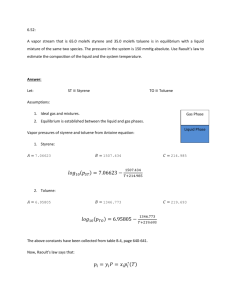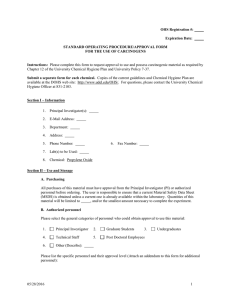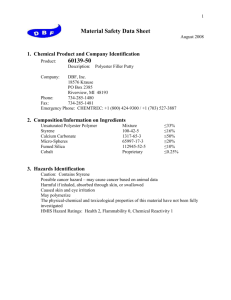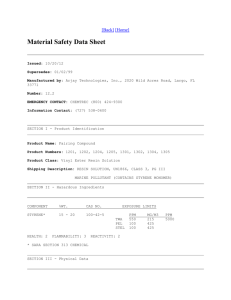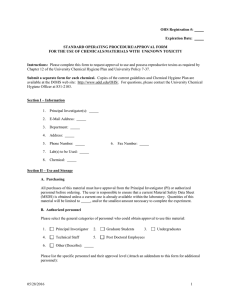OHS Registration #: Expiration Date: STANDARD OPERATING PROCEDURE/APPROVAL FORM
advertisement
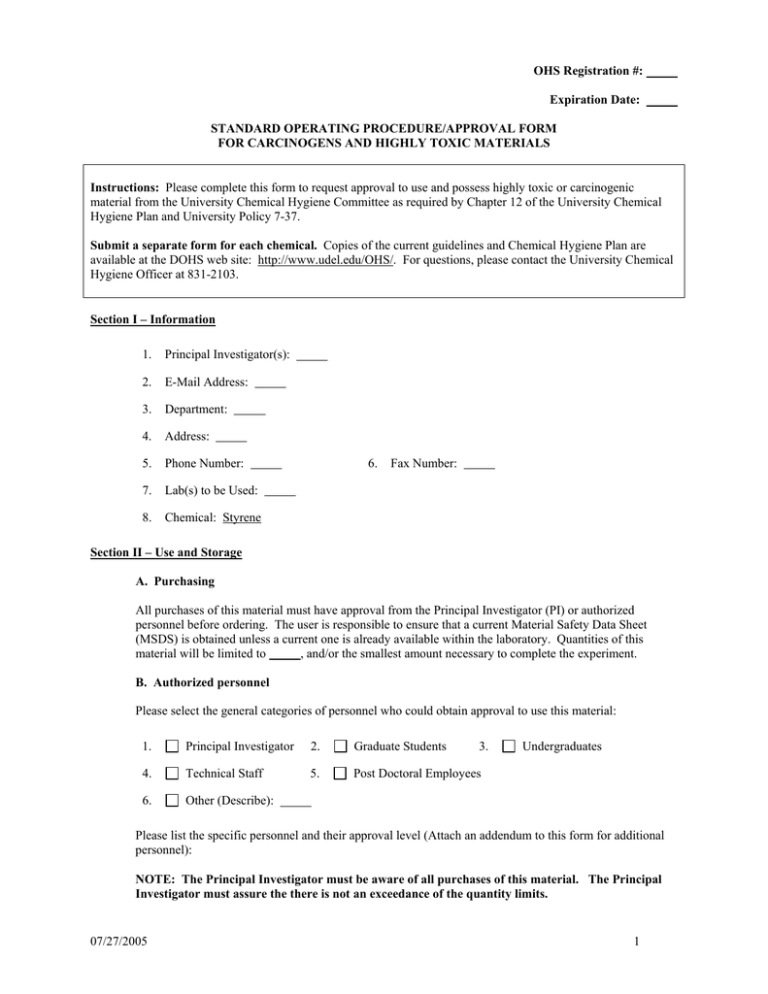
OHS Registration #: Expiration Date: STANDARD OPERATING PROCEDURE/APPROVAL FORM FOR CARCINOGENS AND HIGHLY TOXIC MATERIALS Instructions: Please complete this form to request approval to use and possess highly toxic or carcinogenic material from the University Chemical Hygiene Committee as required by Chapter 12 of the University Chemical Hygiene Plan and University Policy 7-37. Submit a separate form for each chemical. Copies of the current guidelines and Chemical Hygiene Plan are available at the DOHS web site: http://www.udel.edu/OHS/. For questions, please contact the University Chemical Hygiene Officer at 831-2103. Section I – Information 1. Principal Investigator(s): 2. E-Mail Address: 3. Department: 4. Address: 5. Phone Number: 7. Lab(s) to be Used: 8. Chemical: Styrene 6. Fax Number: Section II – Use and Storage A. Purchasing All purchases of this material must have approval from the Principal Investigator (PI) or authorized personnel before ordering. The user is responsible to ensure that a current Material Safety Data Sheet (MSDS) is obtained unless a current one is already available within the laboratory. Quantities of this material will be limited to , and/or the smallest amount necessary to complete the experiment. B. Authorized personnel Please select the general categories of personnel who could obtain approval to use this material: 1. Principal Investigator 2. Graduate Students 4. Technical Staff 5. Post Doctoral Employees 6. Other (Describe): 3. Undergraduates Please list the specific personnel and their approval level (Attach an addendum to this form for additional personnel): NOTE: The Principal Investigator must be aware of all purchases of this material. The Principal Investigator must assure the there is not an exceedance of the quantity limits. 07/27/2005 1 1. Purchase Use the Material 2. Purchase Use the Material 3. Purchase Use the Material 4. Purchase Use the Material 5. Purchase Use the Material The Principal Investigator will update this section when any personnel changes occur. If changes occur, document the changes (include the record of training of additional personnel) in the laboratories files and submit an addendum to the University Chemical Hygiene Officer with all training documentation. C. Storage Materials will be stored according to compatibility and label recommendations in a designated area. 07/27/2005 1. Please list compounds that this chemical is incompatible with: WARNING: May decompose violently or explosively on contact with other substances. This substance is one of the relatively few compounds which are described as "endothermic" i.e. heat is absorbed into the compound, rather than released from it, during its formation. The majority of endothermic compounds are thermodynamically unstable and may decompose explosively under various circumstances of initiation. Many but not all endothermic compounds have been involved in decompositions, reactions and explosions and, in general, compounds with significantly positive values of standard heats of formation, may be considered suspect on stability grounds. Segregate from strong oxidisers and acids. DO NOT USE brass or copper containers / stirrers. Attacks, softens and may dissolve rubber, many plastics, paints and coatings. 2. Please list special storage requirements (I.E.: Refrigerated, Inert Atmosphere, Desiccated, etc.): Stable under controlled storage conditions provided material contains adequate stabiliser / polymerisation inhibitor. Bulk storages may have special storage requirements . Storage requires stabilising inhibitor content and dissolved oxygen content to be monitored. Refer to manufacturer's recommended levels. DO NOT overfill containers so as to maintain free head space above product. Blanketing or sparging with nitrogen or oxygen free gas will deactivate stabiliser. Inhibitor level should be regularly checked to maintain stability. Store in original containers in approved flammable liquid storage area. DO NOT store in pits, depressions, basements or areas where vapors may be trapped. No smoking, naked lights, heat or ignition sources. Keep containers securely sealed. Store away from incompatible materials in a cool, dry, well-ventilated area. Protect containers against physical damage and check regularly for leaks. Observe manufacturer's storing and handling recommendations. Easily peroxidisable. Products formed as a result of peroxidation are not only safety hazards but may chemically alter the chemical behavior of the parent compound. Should have a warning label affixed bearing the date of receipt in the laboratory and the date on which the container label is first opened, or laboratory synthesised materials are the responsibility of the individual chemist. WARNING: This product may form peroxides which themselves are not Quantities of uninhibited monomers exceeding 500 ml should not be stored for more than 24 hours. The oxidation of iodide to iodine or the conversion of colourless ferrothiocyanate to red ferrithiocyanate by peroxides are simple and convenient tests for most peroxides. Before distilling or evaporating a suitable polymerisation inhibitor should be added. Leave at least 10% bottoms. Use a shield when evaporating or distilling mixtures which may contain peroxidisable compounds. Store away from heat and light. Particular attention should be paid to the adequacy of the closure on storage containers. Peroxides may be removed by; (1) passing the material over a column of ordinary activated alumina (care should be taken in disposal of the activated alumina); (2) shaking with a concentrated solution of ferrous salt (provided the carrier solvent is water-insoluble); (3) agitation with an approximately equimolar mixture of ferrous sulfate and sodium bisulfate; (4) commercial quantities may be treated with a 5% solution 2 of aqueous sodium carbonate. Jackson et al: Control of Peroxizable Compounds; Safety in the Chemical Laboratory, Journal of Chemical Education; Vol 47, 1970, pp A175-A188 When solvents have been freed from peroxides by percolation through a column of activated alumina, the adsorbed peroxides must promptly be desorbed by treatment with polar solvents, methanol or water, which must in turn be discarded safely.***. 3. Please list specific storage area (This Area Must be Marked and Labeled): Storage areas will be inspected by laboratory personnel on a regular basis. Personnel will check for safety concerns such as improper storage, leaking/damaged container(s), damaged labels, quantities in excess of approved limits, theft/disappearance of material, etc. The inspector will also determine if an inventory reduction is possible. The Principal Investigator will designate one individual to complete this inspection. 4. Please select an inspection frequency: Weekly Biweekly Bimonthly Monthly D. Use location: Materials shall be used only in the following designated areas. Check all that apply: 1. Demarcated Area in Lab (Describe): 2. Fume Hood 4. Other (Describe): 3. Glove Box Section III – Personnel Safety and Protection A. Training requirements: All users must demonstrate competency and familiarity regarding the safe handling and use of this material prior to purchase. The Principal Investigator is responsible for maintaining the training records for each user of this material. Training should include the following: 1. Review of current MSDS 2. Review of the OSHA Lab Standard 3. Review of the Chemical Hygiene Plan 4. Special training provided by the department/supervisor (Right to Know) 5. Review of the departmental safety manual if applicable 6. Safety meetings and seminars 7. One-on-One hands-on training with the Principal Investigator or other knowledgeable laboratory personnel. B. Personal Protective Equipment: 07/27/2005 3 All personnel are required to wear the following personal protective equipment whenever handling this material: 1. Proper Laboratory Attire (Pants or dresses/shorts below the knees, sleeved shirt, close-toe shoes) 2. Safety Glasses 3. Lab Coat Personnel may be required to wear other Personal Protective Equipment when working with this material. The Principal Investigator should contact the University Chemical Hygiene Officer to discuss the selection of chemical protective clothing (aprons, suits and gloves) and respirators. Please check all that apply: 1. 3. Chemical Safety Splash Goggles 2. Face Shield Chemical Protective Gloves (Describe): Silver Shield, Viton, Polyvinyl Alcohol, Butyl Rubber 4. Chemical Protective Clothing (Describe): 5. Chemical Protective Splash Apron (Describe): 6. Respirator (Type): 7. Other (Describe): C. Safe Work Practices The following safe work practices should be employed when using this material: 1. Wear all required personal protective equipment 2. Cover open wounds 3. Wash hands thoroughly when work with the material is completed 4. No mouth pipetting 5. Use of sharps, such as glass Pasteur pipettes, needles, razor blades, etc. should be avoided or minimized 6. Must not work alone in the laboratory 7. Please list any other safe work practices: Use in a well-ventilated area. Prevent concentration in hollows and sumps. Avoid smoking, naked lights or ignition sources. Avoid generation of static electricity. DO NOT use plastic buckets. Use spark-free tools when handling. Atmosphere should be regularly checked against established exposure standards to ensure safe working conditions. CONDITIONS CONTRIBUTING TO INSTABILITY: Material contains a stabiliser / polymerisation inhibitor system that provides workable but not indefinite shelf life. Storage at higher temperatures and long term storage may result in polymerisation with solidification. In larger quantities e.g. 200 l drums, this may result in generation of heat (exotherm) which may release highly irritating hot vapour. DO NOT open hot exotherming drums - cool externally with water to avoid vapour release. Polymerisation may occur at elevated temperatures. Polymerisation may be accompanied by generation of heat as exotherm. Process is self accelerating as heating causes more rapid polymerisation. Exotherm may cause boiling with generation of acrid, toxic and flammable vapour. Polymerisation and exotherm may be violent if contamination with strong acids, amines or catalysts occurs. Polymerisation and exotherm of 8. 07/27/2005 4 material in bulk may be uncontrollable and result in rupture of storage tanks. Polymerisation may occur if stabilising inhibitor becomes depleted by aging. Stabilising inhibitor requires dissolved oxygen to be present in liquid for effective action. Specific storage requirements must be met for stability on ageing and transport. D. Personnel Decontamination For most exposures, decontamination should occur as follows: 1. Small Skin Exposures – a. b. c. d. 2. Eye Exposure – a. b. c. d. e. 3. Wash contaminated skin in sink with tepid water for 15 minutes Have buddy locate the MSDS Wash with soap and water Contact Occupational Health and Safety at 831-8475 for further direction Locate the emergency eye wash Turn eye wash on and open eyelids with fingers Rinse eyes for 15 minutes Have buddy contact 911 for the Newark Campus, 911 for all others and locate the MSDS Notify OHS Large Body Area Exposure – a. b. c. d. e. f. Locate the emergency safety shower Stand under shower and turn it on Rinse whole body while removing all contaminated clothing Have buddy contact 911 for the Newark Campus, 911 for all others and locate the MSDS Rinse body for 15 minutes Notify OHS Please list any special decontamination procedures: E. Exposure Symptoms and Treatment Please list the emergency procedures to be followed in the event of an exposure. These will be found in the MSDS for the compounds: 1. Skin/eye contact: a. 07/27/2005 Symptoms: EYE - This material can cause eye irritation and damage in some persons. The use of a quantity of material in an unventilated or confined space may result in increased exposure and an irritating atmosphere developing Before starting consider control of exposure by mechanical ventilation. The vapour when concentrated has pronounced eye irritation effects and this gives some warning of high vapour concentrations. If eye irritation occurs seek to reduce exposure with available control measures, or evacuate area. The material may produce severe irritation to the eye causing pronounced inflammation. Repeated or prolonged exposure to irritants may produce conjunctivitis. SKIN 0 Skin contact with the material may damage the health of the individual; systemic effects may result following absorption. This material can cause inflammation of the skin on contact in some persons. Toxic effects may result from skin absorption. Bare unprotected skin should not be exposed to this material. The material may accentuate any pre-existing dermatitis condition. The material may cause skin irritation after prolonged or repeated exposure and may produce on contact skin redness, swelling, the production of vesicles, scaling and thickening of the skin. 5 b. 2. 3. 4. 07/27/2005 First Aid: Rinse with water in a emergency eye wash or safety shower while removing contaminated clothing for 15 minutes. Seek emergency medical care by dialing 911. Ingestion: a. Symptoms: HARMFUL-May cause lung damage if swallowed. Although ingestion is not thought to produce harmful effects, the material may still be damaging to the health of the individual following ingestion, especially where pre-existing organ (e.g. liver, kidney) damage is evident. Present definitions of harmful or toxic substances are generally based on doses producing mortality (death) rather than those producing morbidity (disease, ill-health). Gastrointestinal tract discomfort may produce nausea and vomiting. In an occupational setting however, ingestion of insignificant quantities is not thought to be cause for concern. Considered an unlikely route of entry in commercial/industrial environments. Ingestion may result in nausea, abdominal irritation, pain and vomiting. b. First Aid: • If swallowed do NOT induce vomiting. If vomiting occurs, lean patient forward or place on left side (head-down position, if possible) to maintain open airway and prevent aspiration. Observe the patient carefully. Never give liquid to a person showing signs of being sleepy or with reduced awareness; i.e. becoming unconscious Give water to rinse out mouth, then provide liquid slowly and as much as casualty can comfortably drink. Contact 911 immediately. Inhalation a. Symptoms: Harmful by inhalation. There is some evidence to suggest that this material, if inhaled, can irritate the throat and lungs of some persons. Inhalation hazard is increased at higher temperatures. Acute effects from inhalation of high vapor concentrations may be chest and nasal irritation with coughing, sneezing, headache and even nausea. If exposure to highly concentrated vapor atmosphere is prolonged this may lead to narcosis, unconsciousness, even coma and unless resuscitated - death. Inhalation of vapour may aggravate a pre-existing respiratory condition. Central nervous system (CNS) depression is seen at styrene exposures exceeding 50 ppm, whilst headache, fatigue, nausea and dizziness are reported consistently at exposures of 100 ppm. Evidence exists that 5% to 10% reductions in sensory nerve conduction occur at 100 ppm and that slowed reaction times occur after exposure to 50 ppm. Exposure at 370 ppm produces unpleasant subjective symptoms and signs of neurological impairment. High vapour concentrations may have a toxic and anaesthetic effect which may lead to unconsciousness or death. Exposure at 1000 ppm can rapidly lead to unconsciousness whilst exposure to 10000 ppm may cause death in less than one hour. Simple reaction times were increased and coordination decreased amongst volunteers inhaling 350 ppm (via mouth tube) for 30 minutes. Controlled inhalation studies with 300 ppm (via mouth tube) for one hour found reduced ocular tracking abilities but no changes in balance or coordination. b. First Aid: Move to fresh air. Seek emergency medical care by dialing 911. Provide CPR if necessary. Injection a. Symptoms: May be fatal b. First Aid: Seek emergency medical care by dialing 911. 6 The ChemWatch MSDS, which is available at http://www.udel.edu/OHS/ oftentimes, has treatment information for Emergency Room Personnel and Doctors to follow. Please list any information that can be provided to assist with the treatment: For acute or short term repeated exposures to styrene: INHALATION: • Severe exposures should have cardiac monitoring to detect arrhythmia. • Catecholamines, especially epinephrine (adrenalin) should be used cautiously (if at all). • Aminophylline and inhaled beta-two selective bronchodilators (e.g. salbutamol) are the drugs of choice for treatment of bronchospasm. INGESTION: • Ipecac syrup should be given for ingestions exceeding 3ml (styrene)/kg. • For patients at risk of aspiration because of obtundation, intubation should precede lavage. • Pneumonitis is a significant risk. Watch the patient closely in an upright (alert patient) or left lateral head-down position (obtunded patient) to reduce aspiration potential. [Ellenhorn and Barceloux: Medical Toxicology] BIOLOGICAL EXPOSURE INDEX - BEI These represent the determinants observed in specimens collected from a healthy worker who has been exposed at the Exposure Standard (ES or TLV): Determinant Index Sampling Time Comments 1. Mandelic acid in urine 800 mg/gm creatinine End of shift NS 300 mg/gm creatinine Prior to next shift NS 2. Phenylglyoxylic acid in urine 240 mg/gm creatinine End of shift NS 100 mg/gm creatinine Prior to next shift 3. Styrene in venous blood 0.55 mg/L End of shift SQ 0.02 mg/L Prior to next shift SQ NS: Non-specific determinant; also seen after exposure to other materials. SQ: Semi-quantitative determinant - Interpretation may be ambiguous; should be used as a screening test or confirmatory test. B: Background levels occur in specimens collected from subjects NOT exposed. F. Spills The laboratory should be prepared to clean up minor spills (25 ml/25 g or less) of highly toxic/carcinogenic materials should they occur in a properly operating fume hood. Chemical spill clean up guidance can be found at http://www.udel.edu/OHS/chemspillkit/chemspillkit.html. Laboratory personnel cleaning up a spill will wear all personal protective equipment listed above and manage all cleanup debris according the waste disposal section. Notify OHS of any spills, even if the lab staff handled the clean-up. Please list the following: 1. Location of Spill Cleanup Materials for a small spill: 2. Any special measures/cleanup material required to cleanup a spill: Remove all ignition sources. Clean up all spills immediately. Avoid breathing vapors and contact with skin and eyes. Control personal contact by using protective equipment. Contain and absorb small quantities with vermiculite or other absorbent material. Wipe up. Collect residues in a flammable waste container. If a spill is large or occurs outside of a fume hood, the laboratory occupants should immediately vacate the laboratory, close all doors and contact Occupational Health & Safety at 831-8475 during working hours or 911 after hours. If the laboratory personnel determine that the spill is not contained to the lab or could cause harm to people outside the laboratory, they should pull the building fire alarm and go to the Emergency Gathering Point to await the University Police and Emergency Responders. The responsible/knowledgeable person should provide the University Police and the Emergency Responders with the following: 07/27/2005 7 1. Common Name of the Material Involved 2. A copy of a MSDS, if possible 3. Any pertinent information related to the emergency, such as location in the lab, other hazards in the lab, etc. G. Emergency Phone Numbers: Below are a list of emergency numbers to contact in the event of an emergency: 1. Police, Fire or Medical Emergency, call – 911 on the Newark Campus, 9-911 for all others 2. Occupational Health & Safety – X8475 Please provide a list of other emergency phone numbers, such as after hour contacts for laboratory personnel or any other important phone number, to be used in the event of an emergency: H. Other Special precautions Please list any other special precautions or procedures not listed in the above sections. Please be as specific as possible: CHRONIC HEALTH EFFECTS Cumulative effects may result following exposure*. Principal routes of exposure are usually by skin contact with the material, skin contact / absorption of the liquid and inhalation of vapour. Exposure to styrene may aggravate central nervous system disorders, chronic respiratory disease, skin disease, kidney disease and liver disease. Occupational styrene exposure causes central and peripheral nervous system effects. It causes a reversible decrease in colour discrimination and in some studies effects on hearing have been reported. Studies of effects of styrene on the haematopoietic and immune systems, liver and kidney, in exposed workers, do not reveal consistent changes. Central nervous system effects of styrene in rats, guinea pigs and rabbits, have been reported. Styrene exposure causes liver and lung toxicity in mice and nasal toxicity in rats and mice. In humans there is little evidence for an association between workplace exposure to styrene and spontaneous abortions, malformations or decreased male fecundity. Spontaneous abortions amongst female worker, exposed to styrene, has been reported in some studies.This finding has not been substantiated in other studies. Increased congenital malformations, embryonic foetal deaths or reduced birth weights have also been reported but simultaneous exposure to other substances makes the link to styrene conjectural. In rats, there is some evidence for reduced sperm count and peripubertal animals may be more sensitive than adult animals. Styrene crosses the placenta in rats and mice. It increases prenatal death at doses levels causing decreased maternal weight gain. Decreased pup weight, postnatal developmental delays as well as neurobehavioral and neurochemical abnormalities have been reported in rats exposed to styrene during preor postnatal development. The potential for developmental toxicity appears to be much higher for styrene7,8-oxide, a metabolite. Neuro-optic pathways have been shown to be particularly vulnerable to organic solvent exposure and studies support the proposition that styrene exposure can induce dose-dependent colour vision loss. In the fibre-glass reinforced plastics industry, visual colour impairment was detected were exposure was above 4 ppm. Campagna D. et al, Neurotoxicology, 17(2), pp 367-374, 1996 Chromosomal abnormalities (micronucleii, chromosome gaps or breaks, nuclear bridges and unscheduled DNA synthesis in peripheral lymphocytes) have been recorded in workers exposed to styrene. Such aberrations however are not always apparent in epidemiological studies and the status of styrene as a DNA effector is equivocal. Death due to cancers among workers exposed to styrene is statistically unremarkable. The dominant first metabolite of styrene is styrene-7,8-epoxide which binds covalently to DNA and shows activity in various in-vitro and in-vivo assays for genetic effects where it induces dose-related responses of chromosomal damage at low concentrations. Styrene-7,8-oxide is detected in the blood of workers exposed to styrene. Adducts in haemoglobin and DNA, DNA single-strand breaks/ alkali-labile sites as well as significant increases in the frequency of chromosomal damage have been found in workers exposed to styrene in the reinforced plastics industry. 07/27/2005 8 Section VI – Waste Disposal The authorized person using this material is responsible for the safe collection, preparation and proper disposal of waste unless otherwise stated below. Waste shall be disposed of as soon as possible and in accordance with all laboratory and University procedures. All personal must obtain chemical waste disposal training via DOHS. Specific instructions: Collect solid waste material in a 7mil polyethylene bag and label with an orange chemical waste label. Collect liquid waste in a "Justrite" container provided by DOHS. Label with a hazardous waste label. Use proper laboratory ventilation such as a fume hood to manage both liquid and solid wastes. Contact DOHS for removal. Do not put in the normal trash or pour any solutions down the drain. 07/27/2005 9 Section V – Signature and Verification Your signature below indicates that you have completed this form accurately to the best of your knowledge, you acknowledge all requirements and restrictions of this form and that you accept responsibility for the safe use of the material. 1. Prepared By: Date: Signature: ______________________________________________ 2. Principal Investigator: Date: Signature: ______________________________________________ 07/27/2005 10 Section VI – Approval Process A. University Chemical Hygiene Officer Approval The Principal Investigator should have this form completed as accurately as possible. Please e-mail or fax this form to the University Chemical Hygiene Officer at eich@udel.edu or 831-1528. The Chemical Hygiene Officer will review and verify the form and make any necessary changes or updates. 1. University CHO: Date: Signature: ______________________________________________ B. Conditional Approval to Purchase and Use This form will then be e-mailed or faxed to a member of the University Chemical Hygiene Committee (CHC), usually from the same department as the requesting PI. The Committee Member will meet with the Principal Investigator or designee and discuss the form and the use of the material. If the Committee Member finds the procedure acceptable, they can offer a conditional approval for purchase and use of this material. 2. CHC Member: Date: Signature: ______________________________________________ C. Full Approval A signed copy of the form will be sent, via campus mail, to the University Chemical Hygiene Officer, who will bring it up at the next Chemical Hygiene Committee Meeting for full approval. All approvals will be good for two years. The complete, signed approval form will kept on file with Occupational Health & Safety and a copy will be sent to the Principal Investigator to keep on file. 3. Acceptance: __________________________________________ Date: CHC Chair: Signature: ______________________________________________ D. Approval Expiration The approval for use and purchase of this material will expire should any of the approved information change, with the exception of Section II, B and C, Authorized Personnel and Storage Location, or two years after CHC approval. If, at the end of two years, the procedure is substantially the same, the Principal Investigator can complete a renewal form and send it to the University CHO, who can approve the renewal for an additional two years. 07/27/2005 11 CHECKLIST FOR POSSESSION AND USE OF CARCINOGENS AND HIGHLY TOXIC MATERIALS The checklist is provided to assist a researcher with the approval process for possession and use of carcinogens and highly toxic materials. This form may be kept on file in the laboratory with the SOP to serve as documentation. The complete procedure can be found in the University Chemical Hygiene Plan in Chapter 12. Date and Initial 1. Complete a Standard Operating Procedure/Approval Form For Carcinogens and Highly Toxic Materials and submit this form to OHS for review 2. Review and make OHS’s changes and recommendations 3. Meet with a member of the University Chemical Hygiene Committee to review the approval form and the use of the material. 4. Submit (via campus mail) the completed and signed form back to the University Chemical Hygiene Officer for conditional approval to purchase and use the material. The University Chemical Hygiene Committee will review this form at the next scheduled meeting for full approval. 5. Complete a Job Hazard Analysis (JHA) for each experiment in which this compound is used. These JHAs must be kept on file in the laboratory and updated every 5 years or when a process changes. 6. Provide and document training for every worker who will use the material. Training shall include hands-on instruction as well as review of the JHA, SOP and the University Chemical Hygiene Plan; specifically Chapter 12. ______________________ 7. Conduct a trial run with OHS present. ______________________ 8. Have OHS present the first time a process using this material occurs. ______________________ ______________________ ______________________ ______________________ ______________________ ______________________ 1



